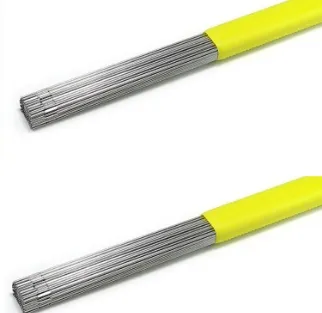Stainless Steel Welding Rods: Types, Prices, and Where to Buy
Stainless steel is known for its strength, corrosion resistance, and clean finish. But to get the full performance from stainless materials, your welds need to be just as strong and corrosion-resistant. That’s why choosing the right stainless steel welding rod is crucial. Whether you’re fabricating for food-grade equipment, pipelines, architecture, or chemical tanks, using the correct rod ensures long-term durability and weld integrity.
This guide breaks down the most common rod types, what influences stainless steel welding rod price, and where to find stainless steel welding rods for sale from reputable suppliers.

What Are Stainless Steel Welding Rods?
Stainless steel welding rods are stick welding electrodes (used in SMAW—Shielded Metal Arc Welding) designed specifically to join stainless steels. These rods are made with a stainless steel core wire and a specialized flux coating that:
Shields the weld pool from atmospheric contamination
Stabilizes the arc
Controls slag and bead profile
Ensures corrosion-resistant metallurgical properties
They’re different from mild steel rods in both chemistry and price, and they’re typically classified by AWS standards (e.g., E308L-16).
Common Stainless Steel Welding Rod Types
Each stainless steel grade has its corresponding rod type, designed to match or complement the base metal:
|
AWS Code |
For Base Metal |
Key Feature |
Typical Applications |
|
E308L |
304/304L |
Low carbon for corrosion resistance |
Tanks, kitchen equipment, piping |
|
E309L |
Dissimilar metals (SS to CS) |
High fusion and ductility |
Transition welds, repair welding |
|
E316L |
316/316L |
Molybdenum alloy for chloride resistance |
Marine, chemical processing |
|
E310 |
High-temp SS |
High Cr/Ni for heat resistance |
Furnaces, heat exchangers |
|
E347 |
Stabilized 347 |
Niobium stabilized for anti-cracking |
Pressure vessels, high-temp piping |
|
E2209 |
Duplex stainless steel |
High strength + corrosion resistance |
Offshore, desalination, structural |
Each rod type comes in different diameters (2.5 mm, 3.2 mm, 4.0 mm, etc.) and may be classified for specific welding positions or current types (DC/AC, all-position, flat only).
Stainless Steel Welding Rod Price (2025 Estimate)
The stainless steel welding rod price depends on several factors:
Rod composition – Higher alloy content (e.g., E316L or E2209) costs more than basic grades like E308L.
Brend – Premium welding brands charge more for consistent arc quality, cleaner slag, and code-compliant product lines.
Packaging size – Sold in 5kg or 20kg boxes; bulk purchases reduce per-kg cost.
Diameter and coating – Larger rods and moisture-resistant coatings (e.g., E308L-15) may cost slightly more.
Region – Local availability, taxes, and import duties influence final pricing.
Average Price Range (per kg, USD):
|
Rod Type |
Price Range (USD/kg) |
|
E308L |
$6.00 – $8.00 |
|
E309L |
$6.50 – $9.00 |
|
E316L |
$7.50 – $11.00 |
|
E310 |
$9.00 – $13.00 |
|
E2209 |
$10.00 – $14.00 |
Bulk or pallet orders can cut prices by 10–20%, especially when buying directly from manufacturers or OEM suppliers.
Where to Find Stainless Steel Welding Rods for Sale
If you’re looking for stainless steel welding rods for sale, consider the following buying options:
1. Local Welding Supply Shops
Convenient for smaller batches or urgent orders
Some stores provide technical advice and WPS support
2. Online Welding Distributors
Websites
Competitive prices and fast shipping
Make sure to check product certification (AWS/ISO)
3. Direct from Manufacturers or OEM Suppliers
Ideal for large contractors, distributors, or fabrication shops
Custom labeling, packaging, and volume pricing
Good option for private label or export orders
When sourcing rods, always request:
Test Certificates or MTCs (for structural or pressure applications)
SDS & TDS documentation
Coating type and storage recommendations
Batch traceability if needed for audits or code welding
Tips for Choosing the Right Stainless Steel Rod
Match the base metal: For example, use E308L on 304 stainless, or E316L on 316.
Consider environment: Saltwater or chemical exposure? Choose molybdenum-bearing alloys like E316L.
Check position rating: Some rods are easier to weld vertically or overhead.
Use proper storage: Keep sealed or re-dry in an oven (250–300°C) before use to avoid porosity.
Stainless Steel Welding Rod FAQs
Q1: Can stainless rods be used on carbon steel?
A: Yes—especially E309L, which is designed to join stainless steel to carbon or mild steel. Just note that the weld metal will be stainless.
Q2: What size rod should I use?
A: Use 2.5 mm or 3.2 mm for most jobs. Thinner rods are better for sheet metal, while 4.0 mm+ is ideal for thick plate welding.
Q3: Are stainless rods harder to weld than mild steel rods?
A: They require more control and produce more heat. Using the correct polarity (typically DC+) and keeping a short arc length will help.
Q4: What’s the difference between E308L-15 and E308L-16?
A: The suffix indicates coating type and polarity. -15 rods are low-hydrogen and DC-only; -16 rods can be used on AC or DC and are more user-friendly for general welding.
Q5: Where can I get stainless steel welding rods at wholesale price?
A: Contact OEM manufacturers, authorized distributors, or use platforms or regional industrial supply chains. Volume orders (500 kg+) yield better deals.
-
What is a medium-frequency pulse? What types of welding are suitable for?YangiliklarNov.24,2025
-
Why is the overall cost of CO2 welding lower than that of shielded metal arc welding?YangiliklarNov.21,2025
-
Welding Knowledge 6YangiliklarNov.20,2025
-
What is a low-frequency pulse? What types of welding are they suitable for?YangiliklarNov.19,2025
-
Why are the weld joints from CO₂ gas shielded welding of such high quality?YangiliklarNov.18,2025
-
J506 Welding Rod - Low Hydrogen, All-Position, AC/DC E7016YangiliklarNov.17,2025


